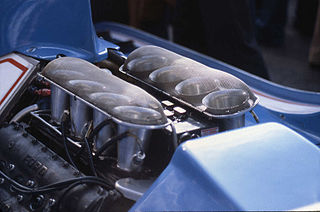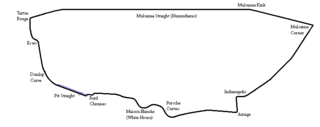Related Research Articles

A V12 engine is a twelve-cylinder piston engine where two banks of six cylinders are arranged in a V configuration around a common crankshaft. V12 engines are more common than V10 engines. However, they are less common than V8 engines.

Cosworth is a British automotive engineering company founded in London in 1958, specialising in high-performance internal combustion engines, powertrain, and electronics for automobile racing (motorsport) and mainstream automotive industries. Cosworth is based in Northampton, England, with facilities in Cottenham, England, Silverstone, England, and Indianapolis, IN, US.

The Ford Kent is an internal combustion engine from Ford of Europe. Originally developed in 1959 for the Ford Anglia, it is an in-line four-cylinder overhead-valve–type pushrod engine with a cast-iron cylinder head and block.

Coventry Climax was a British forklift truck, fire pump, racing, and other speciality engine manufacturer.

British Racing Motors (BRM) was a British Formula One motor racing team. Founded in 1945 and based in the market town of Bourne in Lincolnshire, it participated from 1951 to 1977, competing in 197 grands prix and winning seventeen. BRM won the constructors' title in 1962 when its driver Graham Hill became world champion. In 1963, 1964, 1965 and 1971, BRM came second in the constructors' competition.

An evolution of the 1964 DOHC prototype “XJ13” engine, the Jaguar V12 engine is a family of SOHC internal combustion V12 engines with a common block design, that were mass-produced by Jaguar Cars for a quarter of a century, from 1971 to 1997, mostly as 5.3‑litres, but later also as 6‑litres, and 7‑litre versions that were deployed in racing. Except for a few low-volume exotic sports car makers, Jaguar's V12 engine was the world's first V12 engine in mass-production. For 17 years, Jaguar was the only company in the world consistently producing luxury four-door saloons with a V12 engine. The V12 powered all three series of the original Jaguar XJ luxury saloons, as well as its second generation XJ40 and X305 successors.

The DFV is an internal combustion engine that was originally produced by Cosworth for Formula One motor racing. The name is an abbreviation of Double Four Valve, the engine being a V8 development of the earlier four-cylinder FVA, which had four valves per cylinder.

In automotive engineering a multi-valve or multivalve engine is one where each cylinder has more than two valves. A multi-valve engine has better breathing and may be able to operate at higher revolutions per minute (RPM) than a two-valve engine, delivering more power.

Repco is an Australian automotive engineering/retailer company. Its name is an abbreviation of Replacement Parts Company and was for many years known for reconditioning engines and for specialised manufacturing, for which it gained a high reputation. It is now best known as a retailer of spare parts and motor accessories.

The Ford Duratec V6, is an aluminum DOHC V6 engine with a 60° bank angle introduced in 1993 with the Ford Mondeo. The primary engineering input came from Porsche, who was developing a similar V6 before selling the engineering to Ford, and Cosworth, who helped with cylinder head manufacturing. The Jaguar AJ-V6 engine is similar but adds variable valve timing.

The Mirage Lightweight Racing Car was a family of race cars built by J.W. Automotive Engineereing (JWAE) at Slough in England, initially to compete in international sports car races in the colours of the Gulf Oil Corporation.

The 1973 24 Hours of Le Mans was the 41st Grand Prix of Endurance and took place on 9 and 10 June 1973. It was the eighth round of the 1973 World Championship of Makes.

The Brabham BT49 is a Formula One racing car designed by South African Gordon Murray for the British Brabham team. The BT49 competed in the 1979 to 1982 Formula One World Championships and was used by Brazilian driver Nelson Piquet to win his first World Championship in 1981.

The McLaren M7A and its M7B, M7C and M7D variants were Formula One racing cars, built by McLaren and used in the world championship between 1968 and 1971. After two relatively unsuccessful years of Formula One competition, the M7A was used to score McLaren's first win at the 1968 Belgian Grand Prix.

The Eagle Mk1, commonly referred to as the Eagle T1G, was a Formula One racing car, designed by Len Terry for Dan Gurney's Anglo American Racers team. The Eagle, introduced for the start of the 1966 Formula One season, is often regarded as being one of the most beautiful Grand Prix cars ever raced at the top levels of international motorsport. Initially appearing with a 2.7L Coventry Climax inline 4-cylinder engine, the car was designed around a 3.0L Gurney-Weslake V12 which was introduced after its first four races. In the hands of team boss Gurney, the Eagle-Weslake won the 1967 Belgian Grand Prix, making Dan Gurney only the second driver at the time, and one of only three to date, to win a Formula One Grand Prix in a car of their own construction. Excluding the Indianapolis 500, that win in Belgium still stands as the only win for a USA-built car as well as one of only two wins of an American-licensed constructor in Formula One. It was also the first win for an American constructor in a Grand Prix race since the Jimmy Murphy's triumph with Duesenberg at the 1921 French Grand Prix.
This article gives an outline of Formula One engines, also called Formula One power units since the hybrid era starting in 2014. Since its inception in 1947, Formula One has used a variety of engine regulations. Formulae limiting engine capacity had been used in Grand Prix racing on a regular basis since after World War I. The engine formulae are divided according to era.
The Ferrari flat-12 engine family is a series of flat-12 DOHC petrol engines produced by Ferrari from 1964 to 1996. The first racing Ferrari flat-12, the Mauro Forghieri-designed Tipo 207, was introduced in the Ferrari 1512 F1 car in 1964. Later flat-12 racing engines were used in Ferrari Formula One and sports racing cars from 1968 until 1980, including the 212 E Montagna, 312 B series, 312 PB and 312 T series. The roadgoing flat-12 engines were introduced with the 365 GT4 BB and were produced in various versions until the end of F512M production in 1996.

The HB is a series of 3.5-litre, naturally-aspirated V8 Formula One racing engines, designed, developed and produced by Cosworth, in partnership with Ford; and used between 1989 and 1994. The customer engines were used by Benetton, Fondmetal, McLaren, Lotus, Minardi, Footwork, Simtek, and Larrousse.
The Weslake V12 engine family is a series of four-stroke, 60-degree, naturally-aspirated, V-12 racing engine, designed, developed and produced by Weslake; between 1966 and 1992.
References
- ↑ A.T. McKenna (2010). Jaguar. p. 10. ISBN 9781617865756.
- ↑ Juraj Porázik, Ján Oravec (1985). Old Time Classic Cars, 1885-1940. p. 204. ISBN 9780668063074.
- ↑ Karl Ludvigsen, Gurney's Eagles: The Fascinating Story of the AAR Racing Cars, Page 31.
- 1 2 3 4 5 6 7 8 9 Uli Cloesen (2016). British Cafe Racers. p. 111. ISBN 9781845848965.
- ↑ The World of Automobiles: An Illustrated Encyclopedia of the Motor Car, Volume 22. 1974. pp. 2544–2546.
- 1 2 3 4 5 6 7 8 9 "Harry Weslake". National Speedway Museum. Retrieved 31 December 2021.
- ↑ Mark Hoyer (Jan 2010). "A Gathering of Strength". Cycle World Magazine. p. 8.
- ↑ Giles Chapman (2021). Jaguar Century: 100 Years of Automotive Excellence. p. 31. ISBN 9780760368664.
- ↑ John Baggott (2013). Frogeye Sprite: The Complete Story. ISBN 9781847976444.
- ↑ Nigel Thorley (2019). The Complete Book of Jaguar: Every Model Since 1935. p. 10. ISBN 9780760363904.
- ↑ Motor Sport, November 1935, Page 35.
- 1 2 3 "Harry Weslake", Speedway Star, 9 September 1978, p. 25
- 1 2 3 Graham Robson (2015). Grand Prix Ford: Ford, Cosworth and the DFV. p. 239. ISBN 9781845846244.
- ↑ Chris Harvey (1978). The Jaguar XK. p. 1. ISBN 9780902280571.
- ↑ "Buyer's guide: Jowett Javelin". Classic and Sportscar. 22 November 2019.
- ↑ David Vizard (2012). David Vizard's How to Port and Flow Test Cylinder Heads. p. 8. ISBN 9781934709641.
- 1 2 Mike Taylor (1 February 2017). "The Gas Flow Giant". Classic Car Weekly.
- ↑ John Price Williams (2001). The MGA. p. 19. ISBN 9781903706565.
- ↑ Horton, Chris (1999). The Encyclopedia of the Car. p. 224. ISBN 1-840670533.
- ↑ "Marque Time - Facel Vega". The Irish Times. 29 September 2004. Retrieved 4 March 2021.
- ↑ Malcolm Bobbitt (2016). Rover P4. p. 69. ISBN 9781845849580.
- ↑ Geoff Stunkard (2016). Landy's Dodges: The Mighty Mopars of "Dandy" Dick Landy. p. 20. ISBN 9781613252482.
- ↑ "US Patent No.2652039". Google Patents. Retrieved 7 February 2021.
- ↑ Cyril Posthumus (1977). Classic Racing Cars. p. 88. ISBN 9780528818431.
- ↑ Christine Blatchford (2011). That'll be the Day: 365 F1 Stories (Part 1). ISBN 9780956939302.
- ↑ Mark Whitelock (2016). Lotus 18: Colin Chapman's U-turn. p. 34. ISBN 9781845845209.
- ↑ Graham Robson (2017). COSWORTH - THE SEARCH FOR POWER. p. 93. ISBN 9781845848958.
- ↑ Michael Oliver (2004). Lotus 49 -The Story of a Legend. ISBN 9781904788010.
- ↑ Robson, Graham (9 October 2015). Grand Prix Ford: Ford, Cosworth and the DFV. ISBN 9781845846244.
- ↑ "Ford Weslake V12".
- ↑ "Ford - Weslake V12".
- ↑ Stuart Turner (1999). Twice Lucky: My Life in Motorsport. ISBN 9781859606025.
- ↑ Karl Ludvigsen (2001). Gurney's Eagles. p. 24. ISBN 9781610609463.
- ↑ John Starkey (2019). Ford vs. Ferrari. ISBN 9781787116184.
- 1 2 3 4 5 6 "Ford - Weslake V12". Motorsport. October 2002.
- ↑ Martin Buckley (2002). Cars: An Encyclopedia of the World's Most Fabulous Automobiles. p. 148. ISBN 9780681783225.
- ↑ "Ford Capri RS". Classic Motoring. 21 June 2011.
- ↑ "Gallery: Restored Capri Makes Race Debut at Classic". Historic Racing News. 30 July 2016.
- 1 2 Walton. J (February 1972). "Tuning topics: driving four fast Cortina Mk. 3s". Motorsport Magazine.
- ↑ "Roundup". Cycle World Magazine. April 1975. p. 33.
- ↑ "Short Subjects". Cycle World Magazine. January 1986. p. 22.
- ↑ Keith Noakes (2015). Motorcycle Road & Racing Chassis: A modern review of the best independents. ISBN 9781845848880.
- ↑ Nigel Clark (2015). Classic Motorcycle Restoration and Maintenance. ISBN 9781847978820.
- 1 2 3 4 "Weslake, Normalair-Garrett, NGL, Emdair (UK)". Engine History. Retrieved 1 January 2022.
- ↑ "Powerboat Diesels". The Motor. Vol. 128. 1965. p. 41.
- ↑ Norman Burr (2015). First Principles: The Official Biography of Keith Duckworth. p. 285. ISBN 9781845845285.
- ↑ "Skidmarks – (Excelsior-Henderson) X Factor Part II". 29 July 2015.
- ↑ American Motorcyclist, December 1992, Page 55.
- ↑ "Weslake Capri". Weslake Capri. Retrieved 1 January 2022.
- ↑ "Race Capri History". Weslake Capri. Retrieved 1 January 2022.
- ↑ "Weslake Engineering". Weslake Engineering. Retrieved 1 January 2022.
- ↑ "Why the brilliant Weslake Cup was a family affair". Goodwood.com. 21 March 2017.